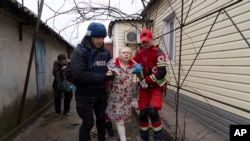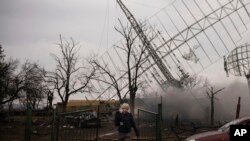With the crackle of gunfire and the thud of a shell hitting in the background, a line of journalists run from a column of flames.
“Let’s go! Go, go, go. Move, take cover,” one yells as they head for safety.
The footage shared by Reuters was shot in the Ukrainian city of Irpin in early March. But it shows a scene becoming more common as journalists report on the conflict.
Already four journalists have been killed and several wounded since Russia invaded on February 24. Others have shared dramatic accounts of close calls.
Two Associated Press journalists — Mstyslav Chernov and Evgeniy Maloletka — this week detailed their time covering the siege of Mariupol and the efforts to bring them to safety before Russian soldiers could reach them.
With risks mounting, media groups and international bodies are increasingly focusing on safety and issuing warnings to remind all sides that journalists are civilians, not targets.
Those warnings came after FOX News journalists Pierre Zakrzewski and Oleksandra Kuvshynova were killed on March 14 near the capital, Kyiv. The U.S. broadcaster’s correspondent Benjamin Hall was seriously injured in the same incident, with FOX saying they were “struck by incoming fire.”
A day earlier, award-winning American filmmaker and journalist Brent Renaud was killed and his colleague Juan Arredondo injured when their vehicle came under fire. And on March 1, Yevhenii Sakun, a Ukrainian camera operator for LIVE TV, was killed during a Russian strike on a TV tower in Kyiv.
“Journalists under international humanitarian law are civilians and attacks on civilians are never acceptable,” said Scott Griffen, deputy director at the Vienna-based International Press Institute (IPI), speaking with VOA.
Griffen added that “targeted attacks on journalists in a conflict zone amount to a war crime.”
Media support
Media watchdogs have become proactive in their response to the dangers inherent to reporting from a conflict zone.
The Paris-based Reporters Without Borders (RSF) on March 12 opened a resource center in the Ukrainian city of Lviv, near the Polish border, to support journalists in the country.
Already the center has provided personal protective equipment, including bulletproof vests and helmets, with gear provided by partners and newsrooms across Europe.
“We hail the courage of journalists,” the center’s coordinator, Alexander Query, said when it opened. “With this center, we are fighting for the independence of the media in Ukraine and beyond it.”
UNESCO is supporting the efforts, providing an initial batch of 125 sets of personal protective equipment as well as training resources through the RSF center and other groups.
“Every day, journalists and media workers are risking their lives in Ukraine to provide life-saving information to local populations and inform the world of the reality of this war,” Audrey Azoulay, director-general of UNESCO, said in a statement last week.
“We are determined to support and protect them in every way possible. UNESCO has been resolutely committed to this since the beginning of the crisis, in close collaboration with its international partners and local professionals,” she added.
The number of journalists killed in conflicts in Iraq and Syria should serve as a reminder for newsrooms to conduct proper risk assessments before sending reporters to Ukraine, Griffen says.
“We know that many media outlets also in the region around Ukraine and Russia have never reported from a war zone before. They may not be accustomed to it. They may not have the right equipment,” he told VOA.
“Obviously, that goes for Ukrainian media as well, which is one of the reasons why we’re trying to make sure that those media also have access to the equipment that they need,” Griffen added.
Trapped by conflict
In the chaos of war, some journalists have gone missing.
In separate incidents, Victoria Roshchina and Oleh Baturyn were reportedly held incommunicado for several days while covering the war. And Ukrainian photojournalist Maks Levin has been missing for nine days.
Roshchina, a reporter covering the conflict for Ukrainian television channel Hromadske, went missing on March 15. Her channel cited local sources as saying Russian forces took her.
Media watchdog Reporters Without Borders (RSF) said Tuesday that Roshchina is now free. She was held by Russian forces and ordered to say on camera that the soldiers had saved her life, RSF reported.
Baturyn, who works for the Ukrainian newspaper Novyi Den, was released Sunday after being held incommunicado for eight days.
His captors, who have not been identified, humiliated and threatened the journalist’s life, the Committee to Protect Journalists says.
The whereabouts of the third journalist, Levin, are unknown. The 41-year-old disappeared after heading to an area of fighting near Kyiv on March 13.
Fighting intensified in that area and a friend, Markiian Lyseiko, told local media that communication between them stopped at 11:23 that morning.
A Culture Of Safety (ACOS) Alliance, an international coalition of news organizations and media rights groups, has stepped up its efforts to provide Ukrainian journalists with support and guidance on safety.
“Our work very much focuses on what can we do so that they don't end up injured, kidnapped or abducted,” Elisabet Cantenys, the group’s executive director, told VOA.
The alliance was set up in 2014 in response to the murders of American freelancers Steven Sotloff and James Foley by the Islamic State militant group in Syria.
ACOS Alliance generally focuses on preventative measures, but the scale of what's happening in Ukraine prompted the group to support not only its member news organizations but all journalists on the ground.
The situation is particularly challenging for many Ukrainian journalists, because “covering this war wasn’t their choice, but they are just being caught in this conflict,” Cantenys said.
She welcomed efforts to provide equipment and other resources.
“It is very important that they (local journalists) have support from each other, from the community at large, from international media organizations in providing them with the PPE that they need and giving them access to some safety advice, even if it’s basic,” Cantenys said.
“Anything can go a long way for them,” she said.







